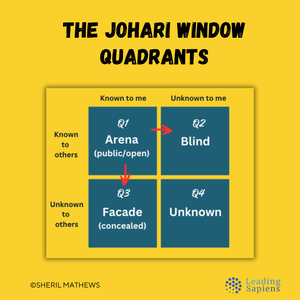"Radical transparency" is often touted as a leadership virtue. So why do leaders still struggle with openness? Using the Johari Window's Quadrant 1 (Open/Arena), this article examines the complexities of leadership transparency and presents a nuanced approach to mastering openness in leadership.
Through the lens of Quadrant 1 (Open/Arena) in the Johari Window, we'll explore strategies to:
- Navigate the fine line between authenticity and oversharing.
- Use thoughtful vulnerability as a leadership enabler.
Imagine a CEO standing before her team, ready to announce a major pivot that could make or break the company. The room is thick with tension. She takes a deep breath and says, "I'm going to be completely transparent with you..."
But should she?
Welcome to the paradox of Quadrant 1 — the deceptively simple “Open Area” or “Arena” that trips up even the most seasoned leaders. While often misunderstood as mere transparency, true openness is both nuanced and purposeful.
Quadrant 1/Open Area of the Johari Window
The Johari Window is a tool for understanding self-awareness and interpersonal relationships. It consists of four quadrants:
- Open Area (Quadrant 1): Known to self and others
- Blind Area: Unknown to self but known to others
- Hidden Area: Known to self but unknown to others
- Unknown Area: Unknown to self and others
Quadrant 1 — the focus of this piece — represents the information, behaviors, and characteristics known to both the individual and others. In leadership, this "Open Area" is crucial for building trust and clear communication.
However, effectively managing this quadrant is far more complex than simply "being transparent."
If you’re not already familiar with the tool, my article below will help:
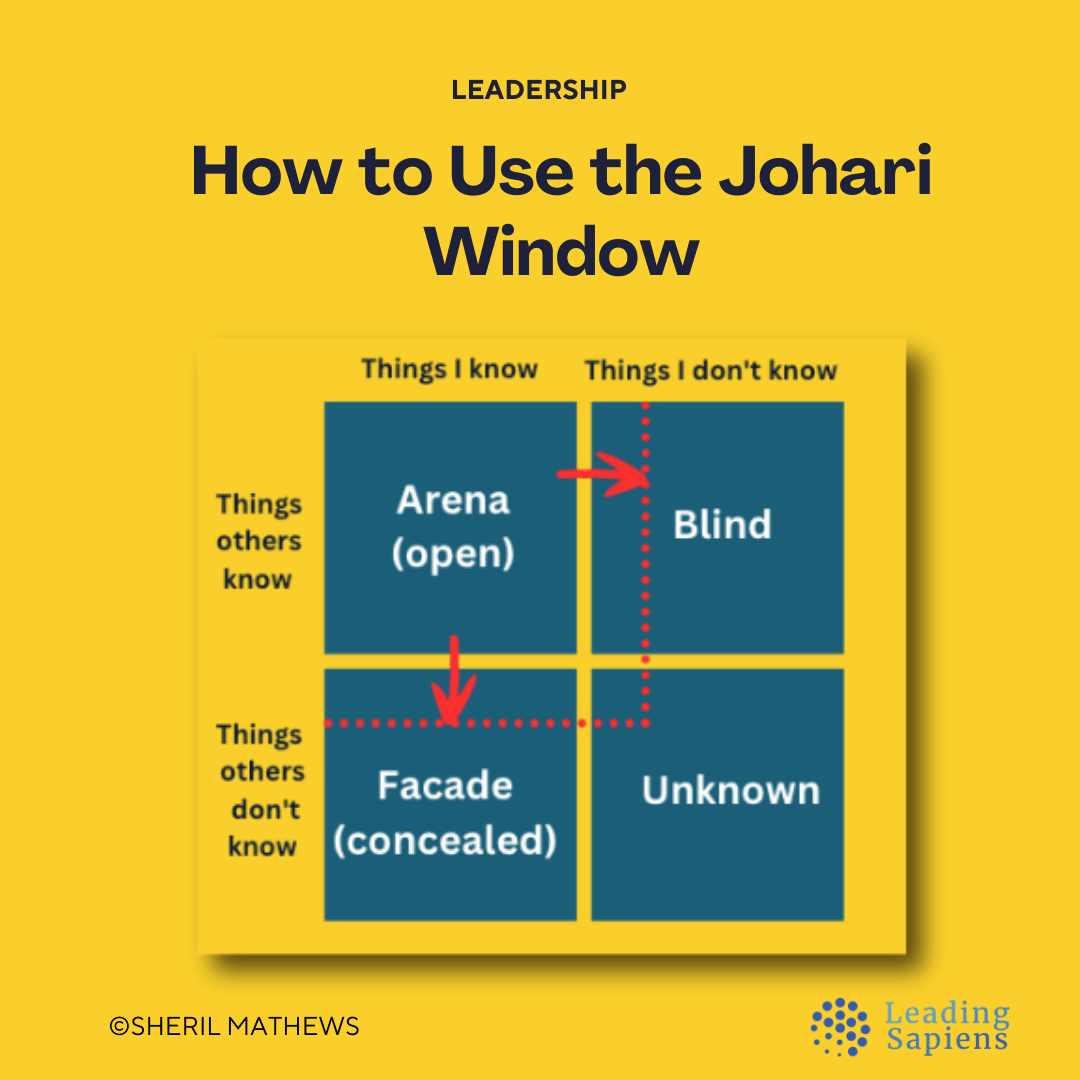
The nature of quadrant 1
Quadrant 1's size influences a leader's cognitive flexibility and relational effectiveness.
Limited openness leads to defensive behaviors and team friction that impair empathy and trust. In contrast, expansive openness enhances flexibility and emotional agility, building authentic connections and influence.
A large Quadrant 1 or Open Arena equips leaders to handle the intricacies of team and stakeholder relationships, especially during organizational stress or transition.
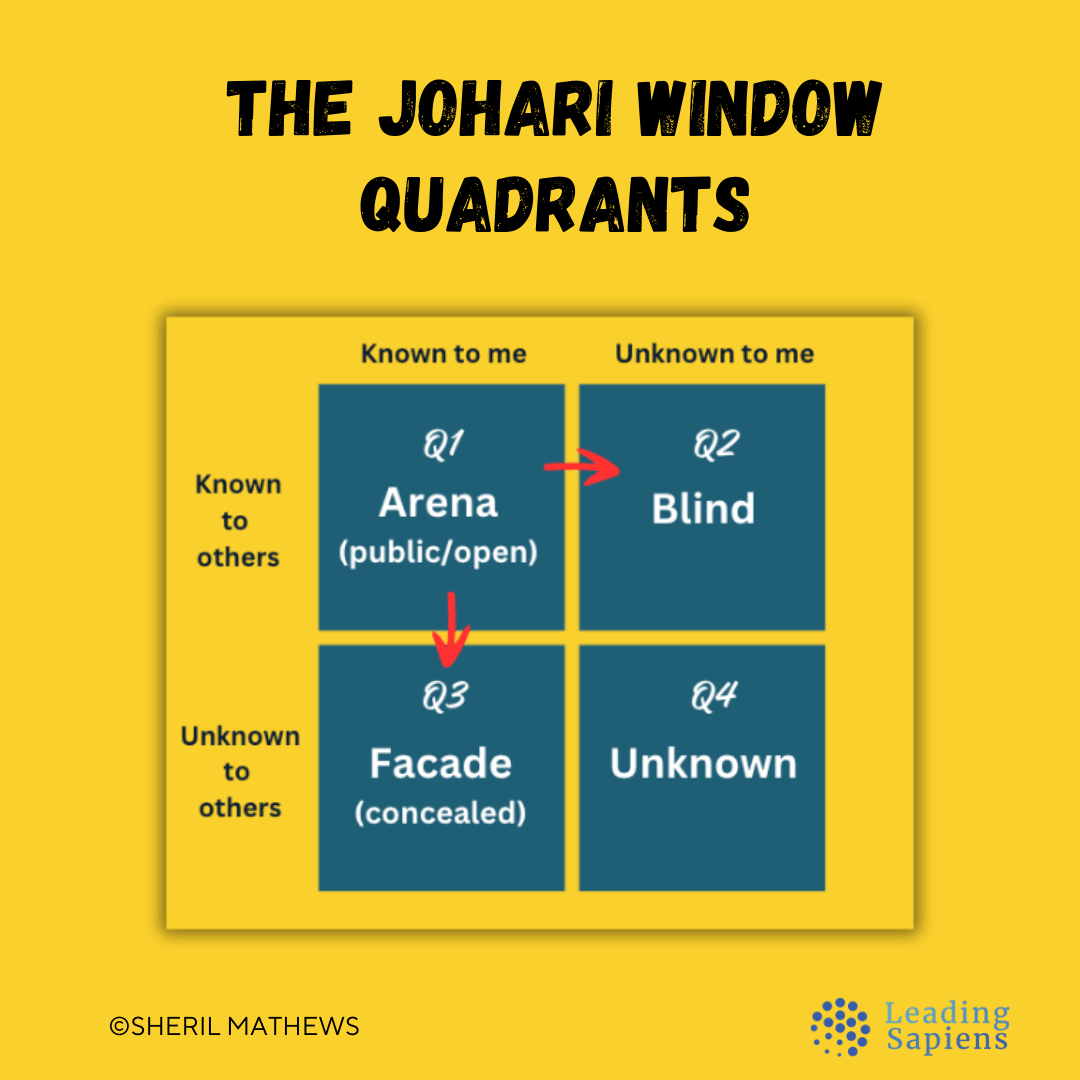
Don’t just share it, frame it.
Quadrant 1 is often oversimplified as sharing and transparency. However, it’s fundamentally about establishing shared reality — a common interpretative space between leader and team, not merely openness for its own sake.
How do you create alignment between your intentions and others' perceptions?
Merely exposing intentions isn’t enough. Effective openness involves creating a reliable shared context.
For instance, clearly articulating the rationale behind strategic decisions doesn’t just inform your team; it provides a coherent frame to interpret future behaviors, minimizing misalignment or confusion.
To create true understanding, build context:
- Explain the 'why' behind the decision.
- Share your reasoning process.
- Highlight key factors influencing the choice.
- Address concerns proactively.
By framing information carefully, you transform anxiety into engagement and alignment.
Adapting your approach
Openness isn't one-size-fits-all. The size and quality of your open quadrant vary depending on the audience, context, and the maturity of relationships.
Match your level of openness to the team's readiness and context:
- New team or crisis: Focus on clear direction and expectations
- Established relationships: Gradually share more vulnerabilities and uncertainties
More openness isn't always better. Sometimes, temporarily withholding information (like during a restructuring) prevents unnecessary panic. The key is to develop situational awareness and make thoughtful decisions about what to share and when.
Openness that motivates senior team members might overwhelm newer employees, creating unnecessary anxiety. Effective leaders use nuanced judgment, calibrating it not by rigid rules but by sensitivity to context and relationships.
Given its importance, how can you increase your quadrant 1/open area? Two primary mechanisms help:
- Increasing disclosure
- Increasing feedback and reflection
Let’s examine these closely.
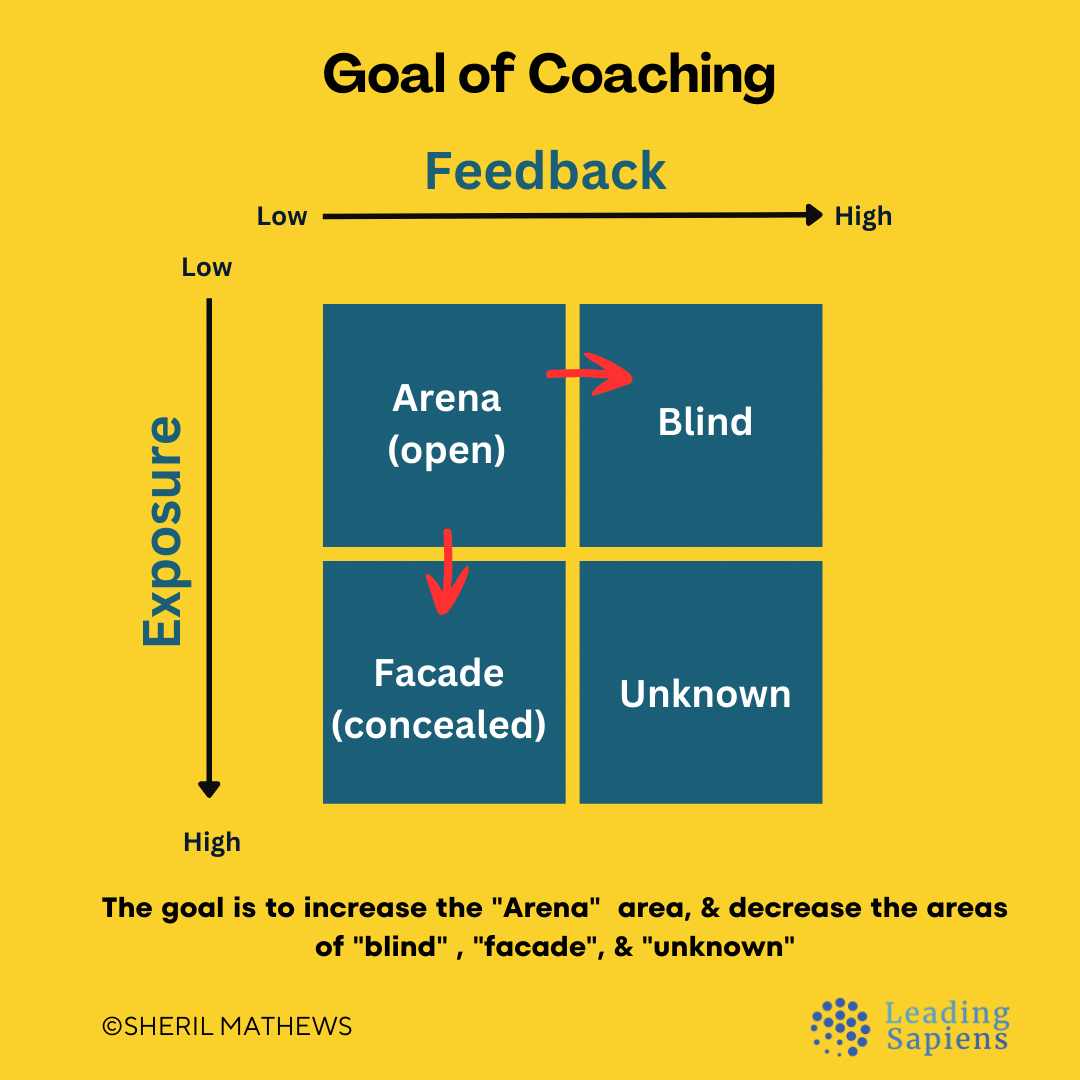
Mastering disclosure
Every interaction shapes others’ perceptions of you. How can you make them work in your favor?
In Quadrant 1 interactions are shaped by the difference between intentional openness and accidental self-disclosure. Leaders must consciously manage both to maximize effectiveness.
Purposeful disclosure
Effective self-disclosure involves selectively sharing information from hidden areas (Quadrant 3) into the open area.
Your openness sets the tone. Acknowledging a personal struggle or uncertainty about a project can build psychological safety by normalizing fallibility. A precise, intentional revelation — like discussing past mistakes to encourage calculated risk-taking — can meaningfully shift team behavior.
When you choose to be open, make it count:
- Share with a clear purpose.
- Focus on relevant information that builds trust or solves problems.
- Avoid dumping unrelated anxieties or doubts.
More on effective self-disclosure:
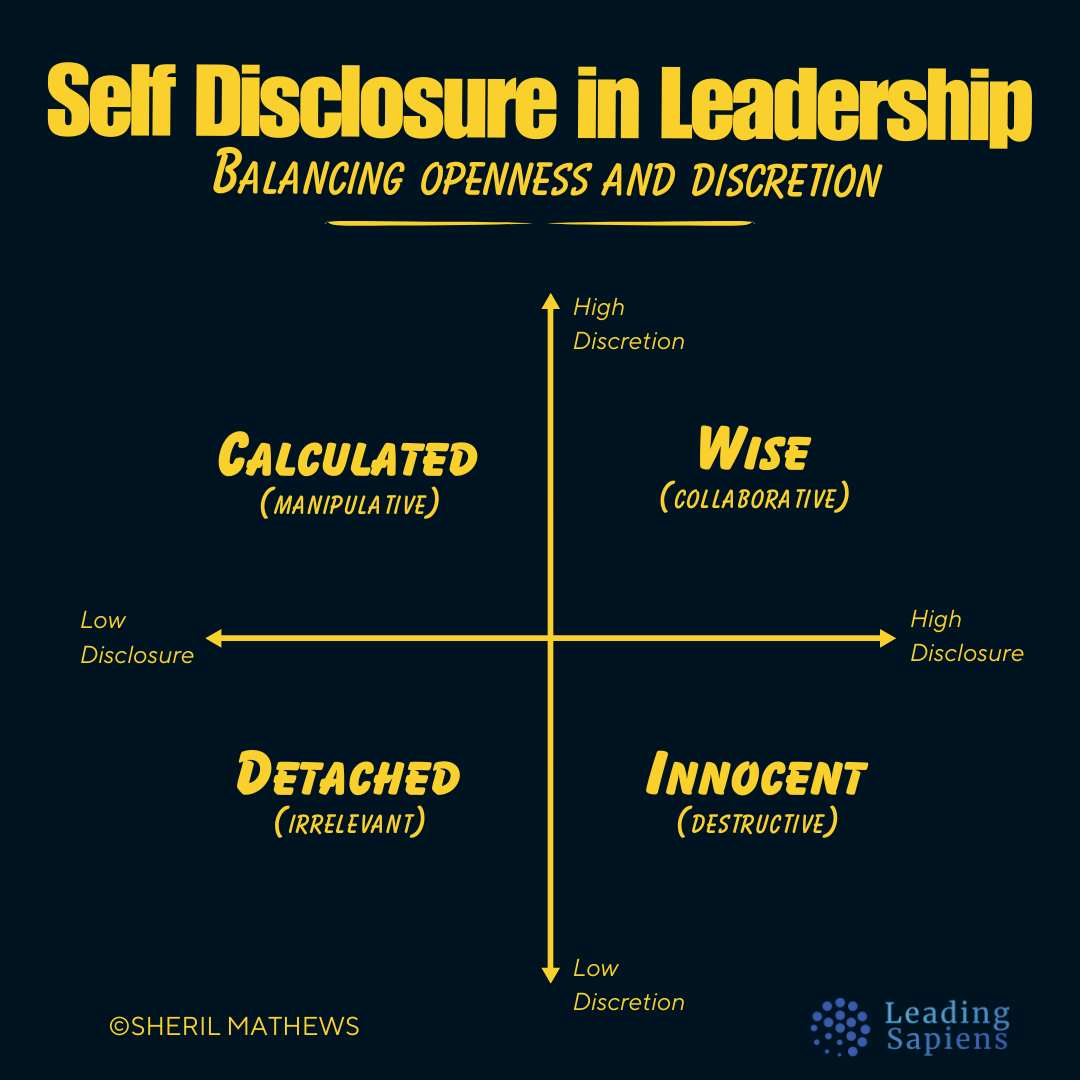
Managing unintended signals
Accidental disclosures—such as shifts in tone, body language, or hesitation— unintentionally reveal anxieties or doubts. Even slight signals, like momentary frustration during meetings, can discourage honest feedback.
The leader’s challenge is twofold: developing heightened self-awareness to recognize these accidental signals in real-time and consciously mitigating their unintended effects.
Develop self-awareness to catch these moments:
- Pay attention to your non-verbal cues.
- Ask trusted colleagues for feedback on your unconscious habits.
- Practice mindfulness to stay present in interactions.
When you catch yourself sending the wrong signal, address it immediately.
Awareness and curiosity
Quadrant 1 leverages a uniquely human capacity: reflective self-awareness combined with intentional curiosity. Thus, effective openness relies on a deep understanding of yourself and genuine interest in others.
These qualities are crucial for expanding and managing one's Open Area. Self-awareness allows leaders to understand what to share and why, while curiosity drives them to seek new information and perspectives, potentially expanding their Open Area.
Reflection: your strategic advantage
Unlike animals driven primarily by instinct, we humans can deliberately redirect our attention, exploring nuances of our actions and experiences from multiple angles.
Leaders who cultivate this reflective habit recognize subtle cues others miss, allowing them to adjust strategies rapidly. Consciously reflecting on team dynamics after a challenging meeting helps identify underlying issues early, preventing conflicts before they escalate.
Make reflection a habit:
- Keep a leadership journal.
- Schedule regular peer feedback sessions.
- Use structured self-assessment tools.
- Set aside time weekly to reflect on your interactions and decisions.
These practices will help you uncover blind spots and refine your self-awareness.
Curiosity: the key to adaptability
People vary in their natural openness to experience and reflection. Those who maintain broad curiosity throughout their careers develop adaptability, thriving amid complexity and uncertainty.
In contrast, those who prematurely narrow their openness — due to past successes or fear of exposure — develop rigid habits and mental models that reduce adaptability, diminishing their effectiveness.
Curiosity is essential for expanding one's Open Area. By seeking new information and perspectives, leaders can bring more knowledge into their shared space, enhancing their ability to genuinely connect.
Develop a habit of noticing subtle cues:
- Watch for shifts in team energy during meetings.
- Watch for hesitations or unasked questions.
- Investigate these signals to uncover hidden concerns or opportunities.
Effective leaders never stop being curious. They:
- Seek new perspectives
- Challenge their assumptions regularly.
- Stay open to feedback, even after success.
Sustained openness builds greater adaptability and resilience.
The paradox of openness
Leaders face the paradox of balancing authenticity with the impulse to mask vulnerability. Genuine authenticity doesn’t mean full transparency; rather, it demands subtlety and sophisticated judgment.
Beyond simplistic authenticity
Authenticity isn’t raw exposure. It means purposefully sharing genuine experiences or feelings that enhance trust and connection without triggering unnecessary concerns. For instance, you may share uncertainties about external market conditions but withhold personal anxieties that can undermine team confidence.
Effective leaders carefully weigh the impact of disclosures, understanding that misplaced openness can burden or mislead teams.
Authenticity in leadership means:
- Sharing vulnerabilities purposefully, not indiscriminately.
- Balancing openness about challenges with clear plans to address them.
- Building trust through carefully chosen moments of transparency.
Avoid oversharing. Ask yourself:
- Will this information provide clarity or motivation?
- Is this the right time and context for this disclosure?
- Am I sharing to truly benefit the team, or for personal reasons?
Thoughtful vulnerability
Intentionally revealing vulnerabilities deepens relational trust, signaling confidence rather than weakness. Leaders adept at vulnerability recognize when openness serves a greater purpose.
The difference between thoughtful vulnerability and damaging exposure lies in the intentionality and specificity of disclosure, highlighting the critical role of discernment in leadership.
Vulnerability, when judicious, can transform your leadership:
- Share past challenges and how you overcame them.
- Admit current growth areas.
- Use your experiences to encourage and inspire others.
Timing is crucial. Share vulnerabilities:
- When you have a clear purpose.
- After developing strong relationships.
- Alongside strategies for overcoming challenges.
Expanding quadrant 1 (open area)
Expanding this quadrant is crucial for a leader’s growth, but not always easy or automatic. It’s achieved through deliberate reflection, active feedback, and challenging self-exposure.
Leaders often face internal and external barriers to increasing their openness. Understanding these challenges is the first step.
A primary barrier is what Thorstein Veblen called “trained incapacity.”
The greatest single source for acquiring more openness is in the matrix of relationships to oneself and to others. Because each of us has, through experience, acquired some "trained incapacity" in functioning in this matrix, I believe that there is a genuine need to find interpersonal experiences which lead to more openness to the world.
— Joseph Luft [1]
Leaders develop habitual patterns — routines, assumptions, and mental shortcuts —that once helped but now inhibit growth. These unconsciously limit openness, turning strengths into rigid blind spots.
Reliance on past successful methods — like micromanagement under stress — can solidify into inflexible leadership styles.
To grow, leaders must challenge the habits and beliefs that brought them initial success. Watch out for:
- Habits that once worked but now limit you.
- Resistance to new ideas or approaches.
- Difficulty adapting to change.
These could indicate that your past successes are holding you back.
Practices for expansion
Breaking habitual blindness demands intentional practices — like structured reflection or feedback sessions — to consistently challenge ingrained assumptions.
Leaders who routinely invite discomfort through controlled challenges, such as seeking contrary opinions or working outside their expertise, can expand their openness, discovering blind spots.
To expand your Open Area:
- Engage in regular structured reflection.
- Seek diverse perspectives and feedback.
- Challenge your assumptions through coaching.
- Experiment with new approaches.
Push yourself out of your comfort zone:
- Take on unfamiliar roles or projects.
- Engage with people who challenge your viewpoints.
- Seek out experiences that force you to adapt.
Exposure to novelty will keep you growing and adapting as a leader. Over time, your "Open Area" in the Johari Window will expand, allowing for more effective communication, stronger relationships, and ultimately, more impactful leadership.
Quadrant 1 as a leadership competency
Quadrant 1 isn’t a passive state or a straightforward ideal — it’s an essential competency demanding cultivation, continuous self-awareness, and judgment. Leaders who develop this quadrant build adaptive capacity and deepen relational trust.
Rather than mere transparency, it’s about leadership maturity: the art of managing openness with clarity, purpose, and depth.
Sources
- Of human interaction by Joseph Luft.
- Hanson, P. (1973). The Johari window: A model for soliciting and giving feedback.
- Luft, Joseph, & Ingham, Harry, (1961). The Johari Window: A Graphic Model of Awareness in Interpersonal Relations.
- The New Johari Window by William Bergquist


